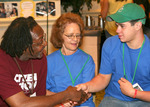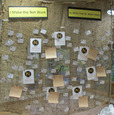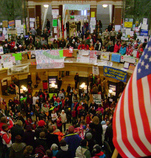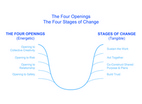December 2011
Taking Care of Our Neighbors
We a living in time of great challenge as our government and economic systems have not delivered the support for people in the way we had come to expect. People are struggling to live decent lives and, increasingly, communities have to create their own solutions in order to create better opportunities. This month we highlight how hunger has surged in our country and what local community members are doing to support our neighbors. We also identify some of the key principles for working in networks. ~ Dale Nienow
Taking Care of Our Neighbors
We a living in time of great challenge as our government and economic systems have not delivered the support for people in the way we had come to expect. People are struggling to live decent lives and, increasingly, communities have to create their own solutions in order to create better opportunities. This month we highlight how hunger has surged in our country and what local community members are doing to support our neighbors. We also identify some of the key principles for working in networks. ~ Dale Nienow
November 2011
Transforming Our Important Public Institutions
The institutions created by our society need to serve the people of our society. When they don't, we need to use our voices to transform these institutions and reclaim their central purpose. One of these vital institutions is public education. This month we share highlights from a national convening the Center hosted on public education and describe the positive role and narrative of education emerging from the voices of educators and journalists engaged in this dialogue. We also profile storytelling/storymaking as an important tool for social transformation. ~ Dale Nienow
Transforming Our Important Public Institutions
The institutions created by our society need to serve the people of our society. When they don't, we need to use our voices to transform these institutions and reclaim their central purpose. One of these vital institutions is public education. This month we share highlights from a national convening the Center hosted on public education and describe the positive role and narrative of education emerging from the voices of educators and journalists engaged in this dialogue. We also profile storytelling/storymaking as an important tool for social transformation. ~ Dale Nienow
October 2011
The Fall (and Rise!) of Dialogue
Effective civic dialogue is vitally needed at this time in our country. Local communities can model how to talk about critical community issues with people from very different backgrounds and perspectives. This month, we highlight an important local economic dialogue that crossed faith and partisan boundaries and cultivated new relationships among Puget Sound neighbors. You will also learn about the questions we ask to help people open up their minds and hearts to these conversations. ~ Dale Nienow
The Fall (and Rise!) of Dialogue
Effective civic dialogue is vitally needed at this time in our country. Local communities can model how to talk about critical community issues with people from very different backgrounds and perspectives. This month, we highlight an important local economic dialogue that crossed faith and partisan boundaries and cultivated new relationships among Puget Sound neighbors. You will also learn about the questions we ask to help people open up their minds and hearts to these conversations. ~ Dale Nienow

August 2011
Fostering Youth-Adult Partnerships
Age is one of the critical boundaries the Center works across to cultivate collective leadership in communities. As societies around the world face great stress and uncertainty, youth can be helpful partners in making changes that improve our communities. This month, we highlight how youth are contributing to social justice movements around the world, the way the Rainier Beach community is tapping into youth voice to support student learning, and a process the Center uses called PhotoVoice to engage community members in sharing stories about their community. ~ Dale Nienow
Fostering Youth-Adult Partnerships
Age is one of the critical boundaries the Center works across to cultivate collective leadership in communities. As societies around the world face great stress and uncertainty, youth can be helpful partners in making changes that improve our communities. This month, we highlight how youth are contributing to social justice movements around the world, the way the Rainier Beach community is tapping into youth voice to support student learning, and a process the Center uses called PhotoVoice to engage community members in sharing stories about their community. ~ Dale Nienow

July 2011
To build strong communities, we need people with the skills to work together collectively. This newsletterhighlights the patterns of collective leadership. I hope you will be inspired by the story of collective leadership in action in a small community, and the reflection questions that help us open to the wisdom of our fellow community members. More stories about collective leadership, can be found in THE COLLECTIVE LEADERSHIP STORYBOOK.
~ Dale Nienow
To build strong communities, we need people with the skills to work together collectively. This newsletterhighlights the patterns of collective leadership. I hope you will be inspired by the story of collective leadership in action in a small community, and the reflection questions that help us open to the wisdom of our fellow community members. More stories about collective leadership, can be found in THE COLLECTIVE LEADERSHIP STORYBOOK.
~ Dale Nienow
May 2011
At the Center, we have learned that creating Gracious Space helps people open to new and deeper relationships that are capable of grappling with difficult issues. This newsletter shares a story of Gracious Space in action, the framework we use to help people open up, and a self-assessment tool you can use in your work. ~ Dale Nienow
At the Center, we have learned that creating Gracious Space helps people open to new and deeper relationships that are capable of grappling with difficult issues. This newsletter shares a story of Gracious Space in action, the framework we use to help people open up, and a self-assessment tool you can use in your work. ~ Dale Nienow
February 2011
Many people have asked us to share more stories from inside our work, our thinking about important issues, and approaches we use to help people cultivate leadership that creates healthy, just and inclusive communities.
I hope you enjoy the story of Roca's work with teenage mothers, the reflection on civic discourse, and how storytelling in Gracious Space can open up relationships. ~ Dale Nienow
Many people have asked us to share more stories from inside our work, our thinking about important issues, and approaches we use to help people cultivate leadership that creates healthy, just and inclusive communities.
I hope you enjoy the story of Roca's work with teenage mothers, the reflection on civic discourse, and how storytelling in Gracious Space can open up relationships. ~ Dale Nienow
|
Using Collective Leadership to Address Community Issues
Chelsea, MA, is a densely populated immigrant community in Boston with one of the highest teenage pregnancy rates in the state. Roca, Inc., a local non-profit that works with high-risk youth, had many of these young mothers come into their agency. As Roca developed programs to support these mothers, they convened a local Community Learning Exchange to discuss strategies for reducing teen pregnancy. |
The Arizona Shooting and the State of Public Discourse
The shooting of citizens assembling in public to talk with their elected representative in Tuscon, AZ, has catalyzed a great deal of reflection and analysis about the current state of public discourse. While the question about the role and consequences of extspeech is currently resonant at the national level, it is not a new question for many of us at the local level. What is the cost of harsh and extreme public comment? |
Difficult Conversations in Gracious Space
When we bring people together from very different perspectives and experiences, it it critical to create the conditions that allow people to feel safe and respected as difficult topics are put on the table. The important first step is to realize that the time dedicated to preparing people to be in demanding conversations is time well spent. Sharing stories invites understanding among people and helps them to challenge assumptions about each other. Recently, we spoke with the executive director of a non-profit agency who described how this worked in her organization. |








